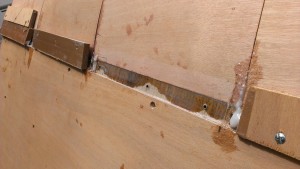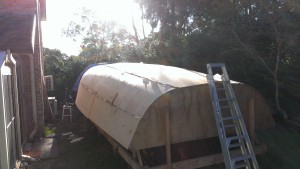The clamping arrangement for the first layer of 6 mm plywood on the radius chine of the Didi 40 Cr has worked well. With the help of a crew member we made up lots of clamps from 280 mm long by 50 mm wide pieces from 12 mm ply. These were predrilled to be a loose fit on a 10 gauge self tapper so that when the self tappers were screwed into the hull the clamp would come down on the 6 mm ply. When fitting the radius chine 300 mm wide strips of 6 mm ply the top clamp was loosely fitted to form a wedge into which the 6 mm ply would fit while the tapers were planed on the strips as required to follow the hull shape. Once the tapering was completed the 300 mm wide plank was glued into position and the clamp on the lower chine pressed hard against the hull while the self tappers were driven home. The self tappers are in line with the stringers and go through the 6 mm rebated of the 12 mm ply flat sections plus the 12 mm of the ply doubler and so far non have pulled out of this 18 mm thick ply section. Once the lower join was completed I then tightened the three self tappers in the upper clamp and then clean up any excess glue before moving to the next plank.
The photo shows a clamp removed and the good tight join left behind. The back side of the clamps are covered in packaging tape which is an excellent mould release material and I have shown the removed clamp next to the join.

First layer of the 6mm radius chine with the clamp removed showing the tight join and the packaging tape on the back side of the removed clamp
The first layer is progressing towards the saloon area and I have had to slow down the planking to complete the potable water tank lining before covering the water tank area. I have now moved around the fattest most curved section of the hull The shadow of the hull on the sides shows that it is very fair even before any sanding prior to the second layer.

The shadow on the hull shows that the radius chine is a series of flats and the high edges will be lightly sanded prior to the second layer.